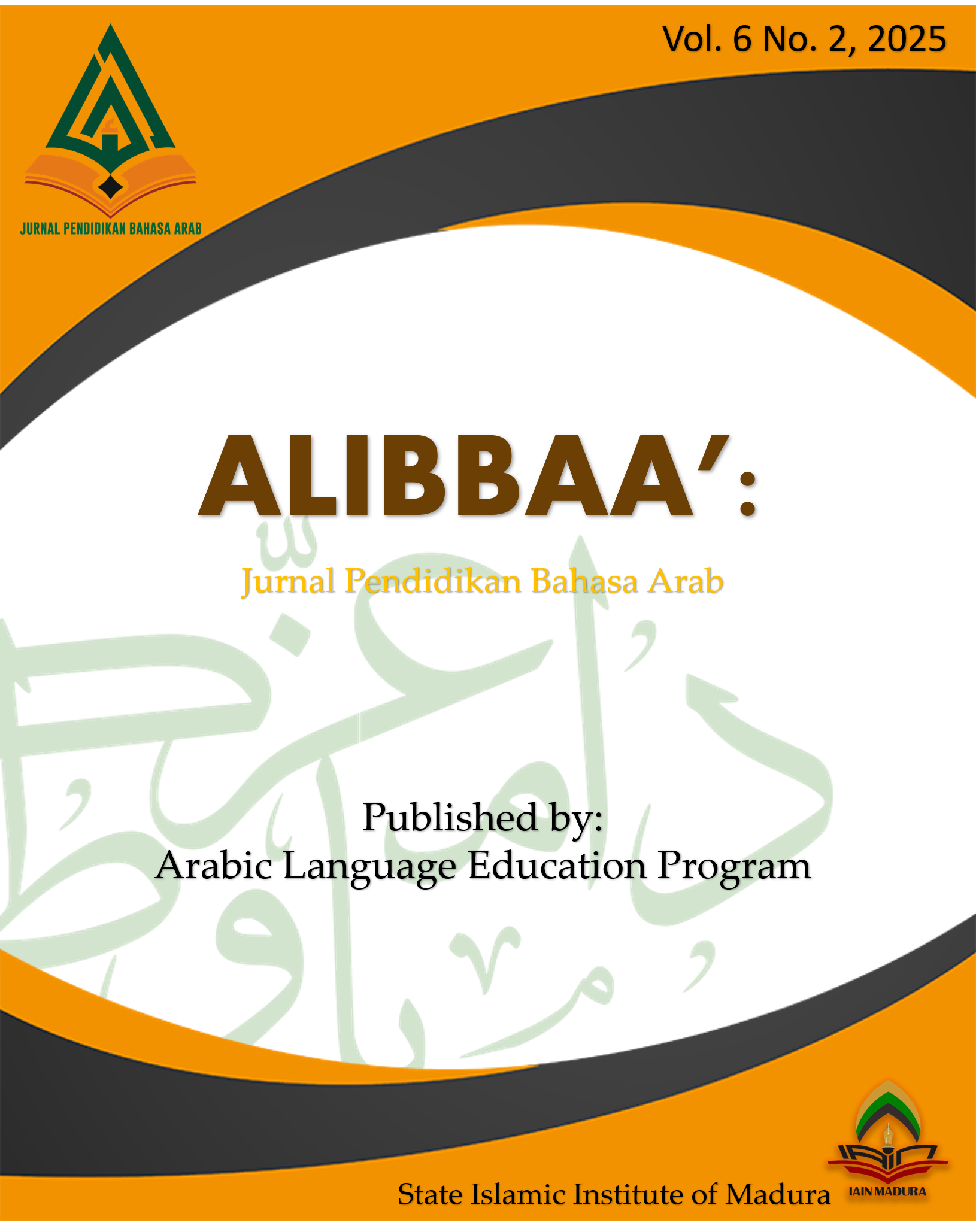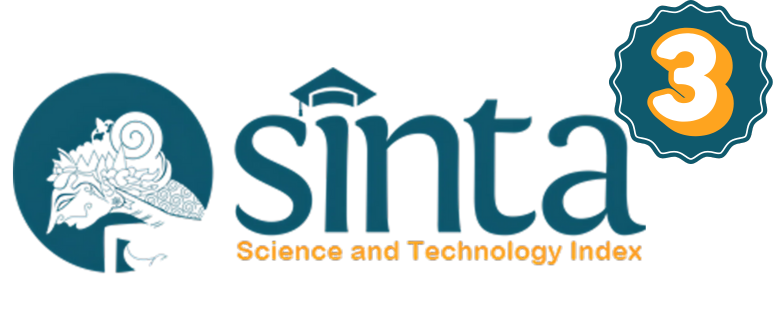Gamified Digital Tools in Arabic Language Instruction: The Case of Froggy Jumps in an Indonesian Secondary Islamic School
 Abstract views: 165
,
Abstract views: 165
,
 pdf downloads: 137
pdf downloads: 137
Abstract
This study investigates the implementation of Froggy Jumps, a gamified digital platform, in enhancing students’ motivation to learn Arabic at an Indonesian secondary Islamic school. The research was conducted using a qualitative case study approach involving eighth-grade students and their Arabic teacher. Data were collected through classroom observations, interviews, and documentation. The findings reveal that Froggy Jumps positively influenced classroom dynamics, increased student engagement, and stimulated learning interest. The gamified elements; points, levels, challenges, audio, and visual features, contributed to a more interactive and enjoyable learning experience. However, the implementation was also influenced by several contextual factors, including internet stability, access to digital devices, and classroom management. The study concludes that while Froggy Jumps is a promising instructional tool, its effectiveness depends on adequate infrastructure, teacher readiness, and responsive pedagogical strategies. Further research using quantitative or mixed methods is recommended to evaluate its impact on student learning outcomes more comprehensively.
Downloads
References
AlDakhil, M., and H. AlFadda. “EFL Learners’ Perceptions Regarding the Use of Busuu Application in Language Learning: Evaluating the Technology Acceptance Model (TAM).” English Language Teaching 15, no. 1 (2021): 1. https://doi.org/10.5539/elt.v15n1p1.
Aswina, Anna Nur, Yasir Arafat, and Susanti Faipri Selegi. “The Influence of The Scientific Learning Approach Assisted by Froggy Jumps on The Indonesia Language Learning Outcomes of Grade IV Elementary School Students.” Jurnal Hurriah: Journal of Educational Evaluation and Research 6, no. 2 (2025): 709–714.
Boudadi, N. Azzouz, and M. Gutiérrez-Colón. “Effect of Gamification on Students’ Motivation and Learning Achievement in Second Language Acquisition within Higher Education: A Literature Review 2011–2019.” The EuroCALL Review 28, no. 1 (2020): 40. https://doi.org/10.4995/eurocall.2020.12974.
Far, Foroutan Far, and M. Taghizadeh. “Comparing the Effects of Digital and Non-Digital Gamification on EFL Learners’ Collocation Knowledge, Perceptions, and Sense of Flow.” Computer Assisted Language Learning 37, no. 7 (2024): 2083–2115. https://doi.org/10.1080/09588221.2022.2146724.
Hadi, N., N. Alvina, and Khaled Radhouani. “Ta’zîzu Dâfi’iyyati Thullâbi Riyâdh al-Athfâl li Tathwîri Mahârât al-Lughah al-’Arabiyyah al-Syafawiyyah min Khilâli Barâmiji al-Ta’lîm al-Mukatstsaf.” Alibbaa’: Jurnal Pendidikan Bahasa Arab 5, no. 2 (2024): 189–214. https://doi.org/10.19105/ajpba.v5i2.12195.
Hamid, M. Abdul, and Sahya Husein. Desain Bahan Ajar Bahasa Arab Berbasis Digital Teori Dan Praktik. Mojokerto: Insight Mediatama, 2024.
Hanifah. “Motivasi Belajar Dalam Pembelajaran Bahasa Arab.” INTAJUNA: Jurnal Hasil Penelitian Studi Kepustakaan, Penilaian, Penerapan Teori Dan Kajian Analisis Di Bidang Pendidikan Bahasa Arab 3, no. 1 (2019): 14–20.
Ismail, H., M. el Ayoubi, M. Qassem, and F. al Areefi. “Assessing the Impact of Gamification Tools’ Usability on Student Engagement: A Comparative Study in Engineering Education.” 2024 4th Interdisciplinary Conference on Electrics and Computer (INTCEC) (2024): 1–8. https://doi.org/10.1109/INTCEC61833.2024.10603117.
Khairani, Beby, Citra Sukma Ayu, Mita Atiqah Ginting, and Sahkholid Nasution. “Analisis Faktor-Faktor Yang Mempengaruhi Minat Belajar Bahasa Arab Siswa MTs Ira Medan.” Indo-MahEdu Intellectual Journal 5, no. 6 (2024): 8007–8018.
Khuluq, M., M. Hasanah, M. Muasshomah, and N. Imamah. “Mobile-Assisted Language Learning Apps: The Analysis of Duolingo.” Al-Ta’rib: Jurnal Ilmiah Program Studi Pendidikan Bahasa Arab IAIN Palangka Raya 12, no. 2 (2024): 229–246. https://doi.org/10.23971/altarib.v12i2.8806.
Kizilcec, R. F., and E. Schneider. “Motivation as a Lens to Understand Online Learners.” ACM Transactions on Computer-Human Interaction 22, no. 2 (2015): 1–24. https://doi.org/10.1145/2699735.
Mayer, R. E. Multimedia Learning, 85–139. 2002. https://doi.org/10.1016/S0079-7421(02)80005-6.
Miles, Matthew B., A. Michael Huberman, and Johnny Saldaña. Qualitative Data Analysis: A Methods Sourcebook. 3rd ed. SAGE Publications, 2014.
Mohzana, M. “Evaluation of the Use of Gamification in Language Learning for Students in Indonesia.” International Journal of Language and Ubiquitous Learning 1, no. 4 (2024). https://doi.org/10.70177/ijlul.v1i4.681.
Nasution, Sahkholid, Hasan Asari, Harun Al-Rasyid, Faridah Faridah, Zulpina Zulpina, and Rafiqa Ulfah Rangkuti. “Arabic Learning and Religious Identity among Non-Muslim Students in Indonesia.” Jurnal Ilmiah Peuradeun 13, no. 2 (2025): 1497–1526. https://doi.org/10.26811/peuradeun.v13i2.2053.
Nasution, Sahkholid, Hasan Asari, Harun Al-Rasyid, Rasyid Anwar Dalimunthe, and Aulia Rahman. “Learning Arabic Language Sciences Based on Technology in Traditional Islamic Boarding Schools in Indonesia.” Nazhruna: Jurnal Pendidikan Islam 7, no. 1 (2024): 77–102. https://doi.org/10.31538/nzh.v7il.4222.
Rahman, Nur Fuadi. “Motivasi Belajar Bahasa Arab (Studi Kasus Mahasiswa PBA IAIN Palangkaraya).” Al-Bayan 10, no. 1 (2018): 22–35.
Rachmawati, Miatin, and Fitri Liza. “Arabic Speaking Skill Using the Educaplay ‘Froggy Jumps’ Application.” Alsuniyat: Jurnal Penelitian Bahasa, Sastra, Dan Budaya Arab 7, no. 1 (2024): 223–234.
Rosell-Aguilar, F. “Autonomous Language Learning through a Mobile Application: A User Evaluation of the Busuu App.” Computer Assisted Language Learning 31, no. 8 (2018): 854–881. https://doi.org/10.1080/09588221.2018.1456465.
Sabilla, Tiara, Toto Edidarmo, A. Fudhaili, Shahid Seif al Din, and Jawhar Youssef. “Tathwîr al-Rusûm al-Hazliyyah al-Raqmiyyah ’alâ Tathbîq Canva li Ta’lîmi Mahârati al-Qirâah Ladâ Thullâbi al-Madrasati al-Ibtidâiyyah al-Islâmiyyah bi Indonesia.” Alibbaa’: Jurnal Pendidikan Bahasa Arab 6, no. 1 (2025): 65–98. https://doi.org/10.19105/ajpba.v6i1.17624.
Shiddiq, J., A. Zubaidi, M. Nur Kholis, and R. Rokhani. “Feasibility of Web-Based Digital Arabic Gamification Media for Islamic Junior High School Students.” Arabiyatuna: Jurnal Bahasa Arab 8, no. 1 (2024): 169. https://doi.org/10.29240/jba.v8i1.8946.
Shortt, M., S. Tilak, I. Kuznetcova, B. Martens, and B. Akinkuolie. “Gamification in Mobile-Assisted Language Learning: A Systematic Review of Duolingo Literature from Public Release of 2012 to Early 2020.” Computer Assisted Language Learning 36, no. 3 (2023): 517–554. https://doi.org/10.1080/09588221.2021.1933540.
Tari, D. K., and D. Rosana. “Contextual Teaching and Learning to Develop Critical Thinking and Practical Skills.” Journal of Physics: Conference Series 1233, no. 1 (2019): 012102. https://doi.org/10.1088/1742-6596/1233/1/012102.
Thurairasu, V. “Gamification-Based Learning as The Future of Language Learning: An Overview.” European Journal of Humanities and Social Sciences 2, no. 6 (2022): 62–69. https://doi.org/10.24018/ejsocial.2022.2.6.353.
Wen, X. “The Effect of Gamification Learning on Primary School Students’ Second Language Learning.” Journal of Education, Humanities and Social Sciences 22 (2023): 492–501. https://doi.org/10.54097/ehss.v22i.12510.
Yin, R. K. Case Study Research and Applications: Design and Methods. 6th ed. SAGE Publications, 2018.
عبد الحكيم عبد الرحمن حسين. “Muhaffazât al-Al’âb al-Raqmiyyah (Gamification) fî Ta’lîmi al-Lughah al-’Arabiyyah: Dirâsatu al-Abhâts al-Mansyûrah fî Tathbîqi Muhaffazâti al-Al’âb al-’Arabiyyah fî Indûnîsiyâ.” Alibbaa’: Jurnal Pendidikan Bahasa Arab 5, no. 1 (2024): 1–29.
Authors who publish with this journal agree to the following terms:
a. Authors retain copyright and grant the journal right of first publication with the work simultaneously licensed under a Creative Commons Attribution License that allows others to share the work with an acknowledgement of the work's authorship and initial publication in this journal.
b. Authors are able to enter into separate, additional contractual arrangements for the non-exclusive distribution of the journal's published version of the work (e.g., post it to an institutional repository or publish it in a book), with an acknowledgement of its initial publication in this journal.
c. Authors are permitted and encouraged to post their work online (e.g., in institutional repositories or on their website) prior to and during the submission process, as it can lead to productive exchanges, as well as earlier and greater citation of published work (See The Effect of Open Access).
Alibbaa': Jurnal Pendidikan Bahasa Arab have CC-BY-SA or an equivalent license as the optimal license for the publication, distribution, use, and reuse of scholarly work.
In developing strategy and setting priorities, Alibbaa': Jurnal Pendidikan Bahasa Arab recognize that free access is better than priced access, libre access is better than free access, and libre under CC-BY-SA or the equivalent is better than libre under more restrictive open licenses. We should achieve what we can when we can. We should not delay achieving free in order to achieve libre, and we should not stop with free when we can achieve libre.

Alibbaa': Jurnal Pendidikan Bahasa Arab is licensed under a Creative Commons Attribution 4.0 International License
You are free to:
- Share — copy and redistribute the material in any medium or format
- Adapt — remix, transform, and build upon the material for any purpose, even commercially.
- The licensor cannot revoke these freedoms as long as you follow the license terms.











